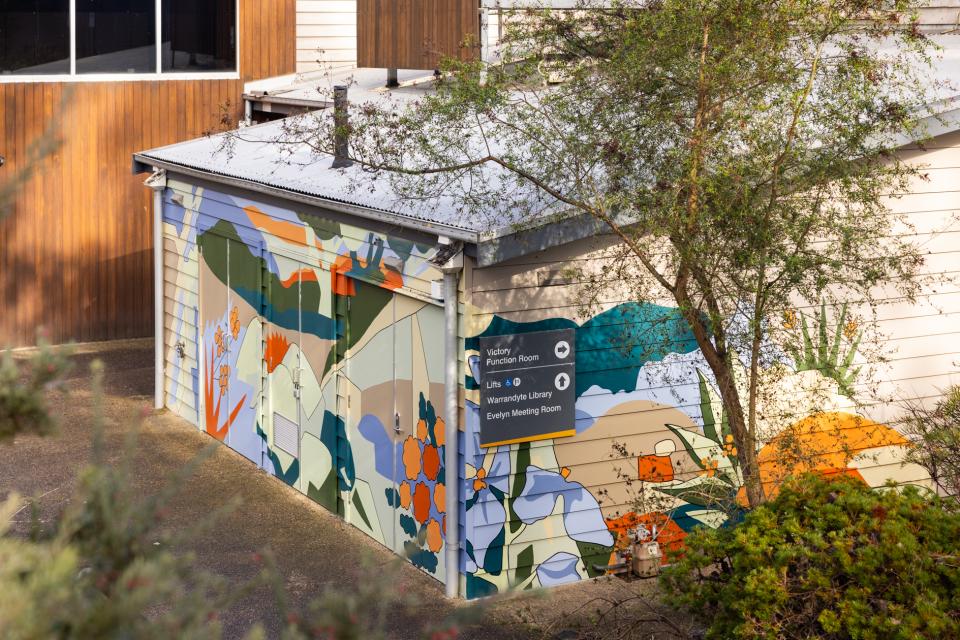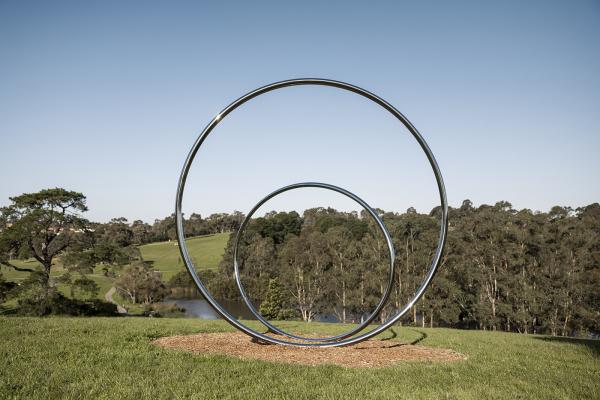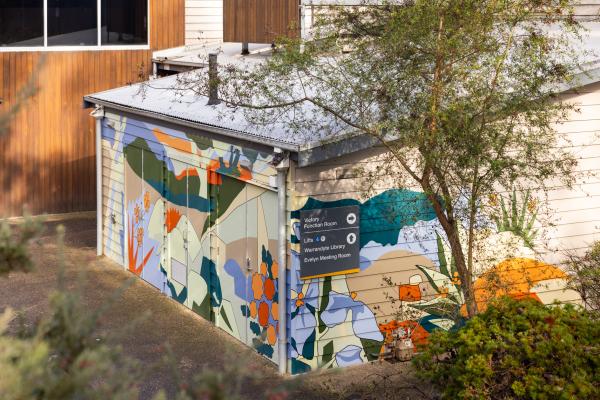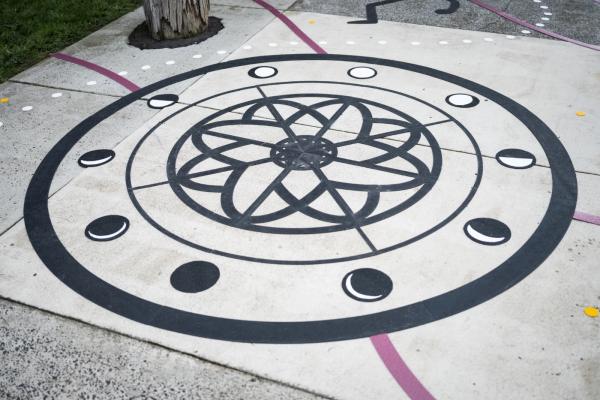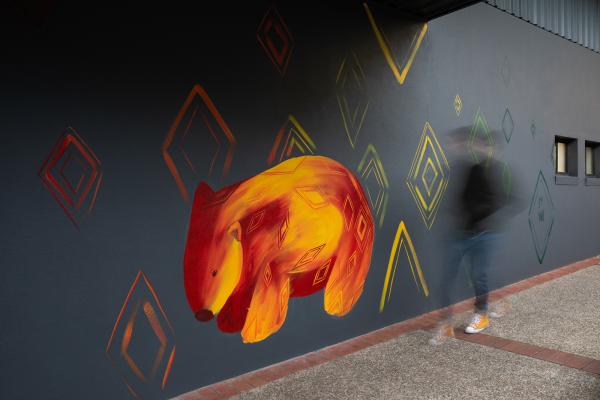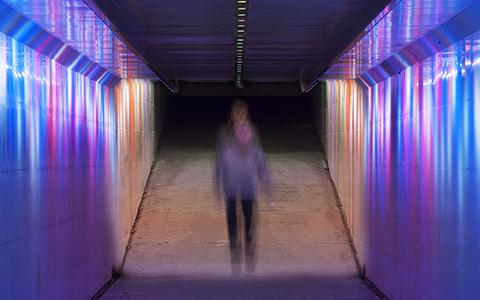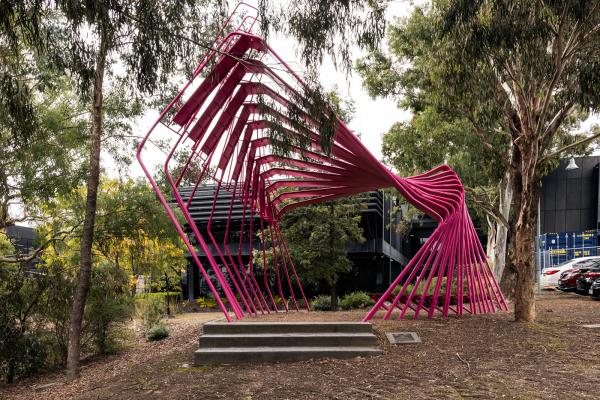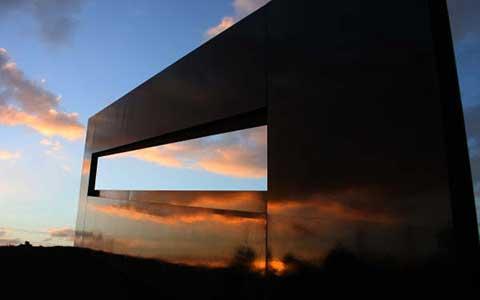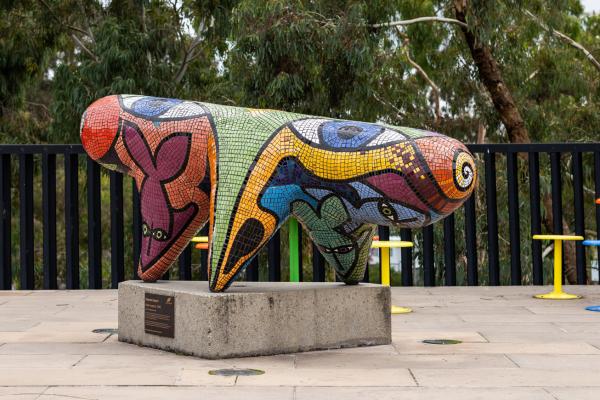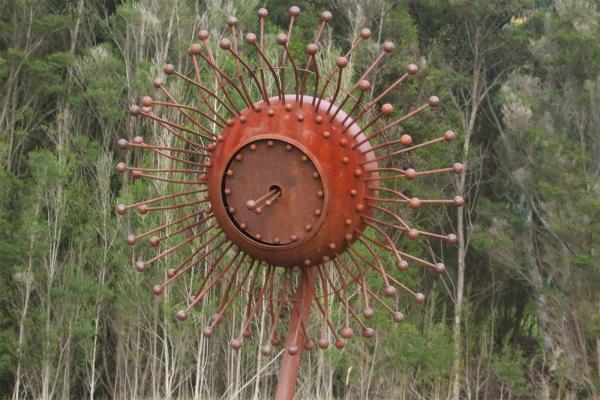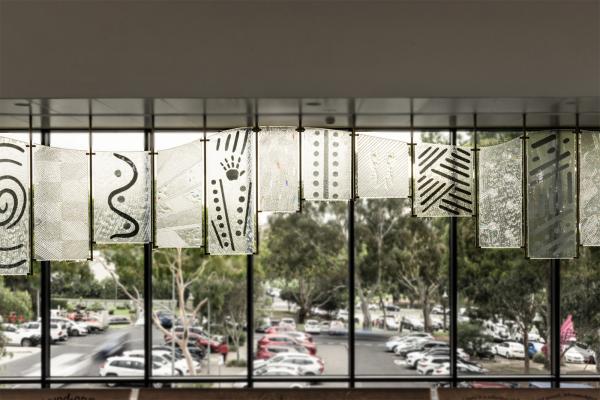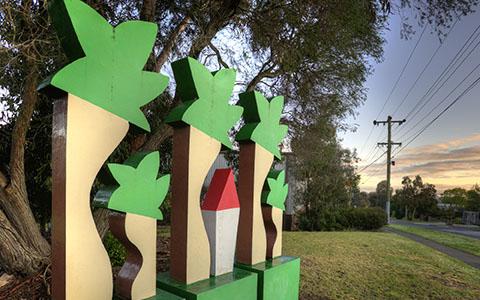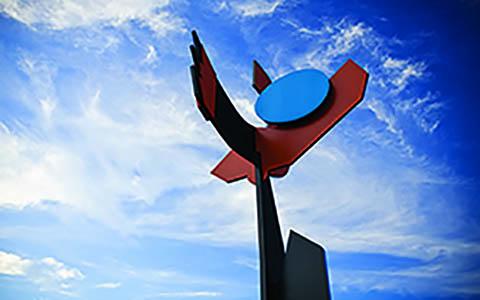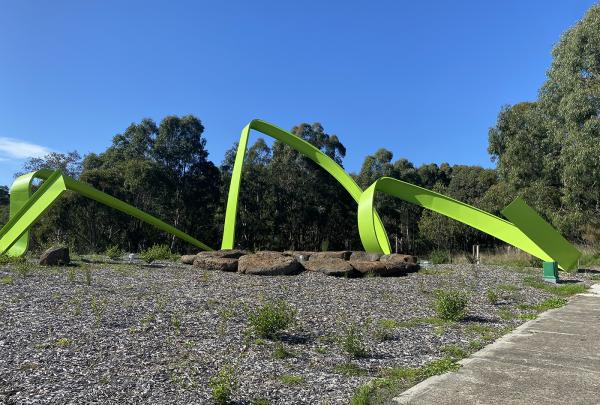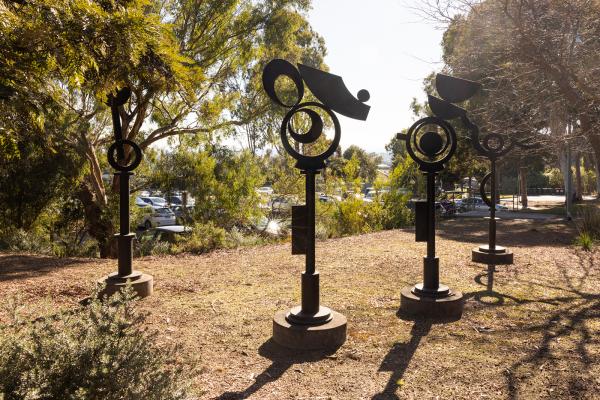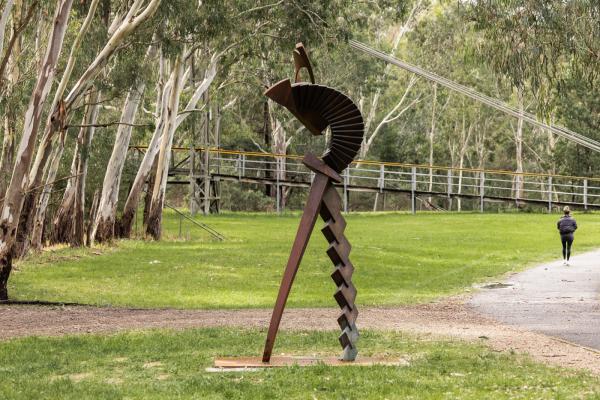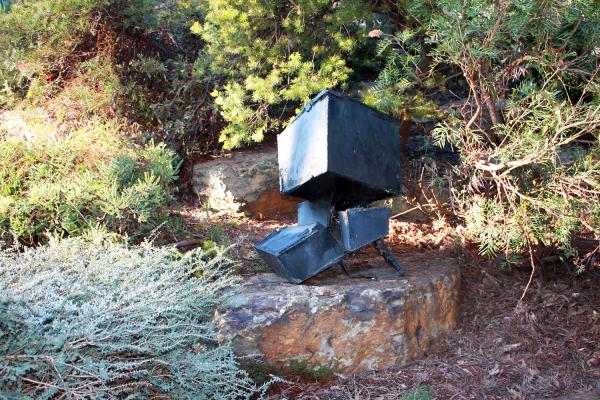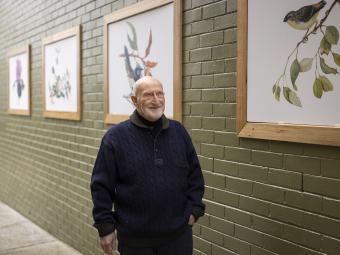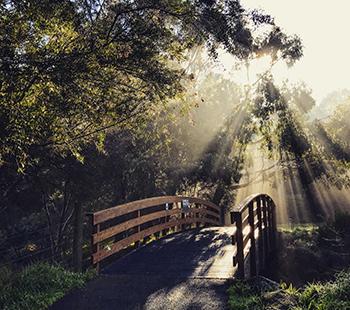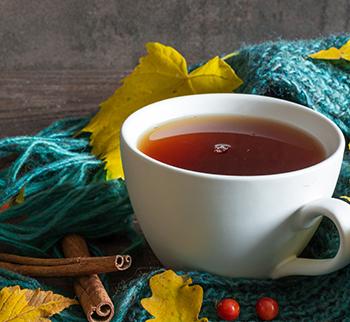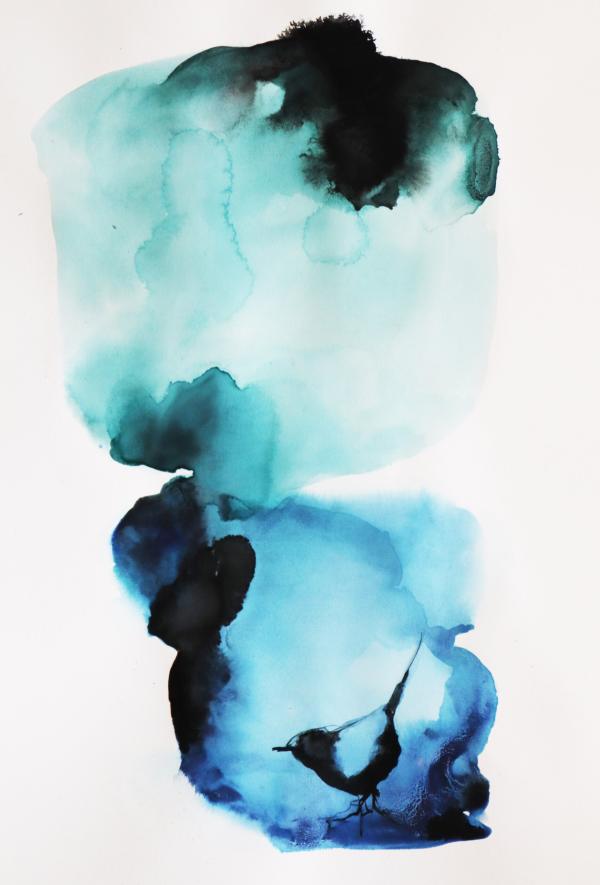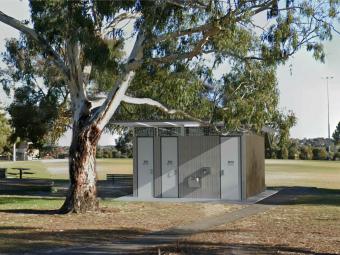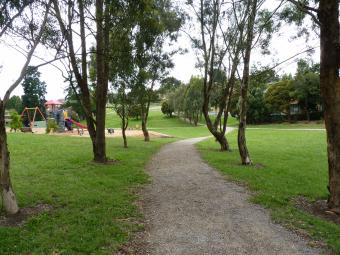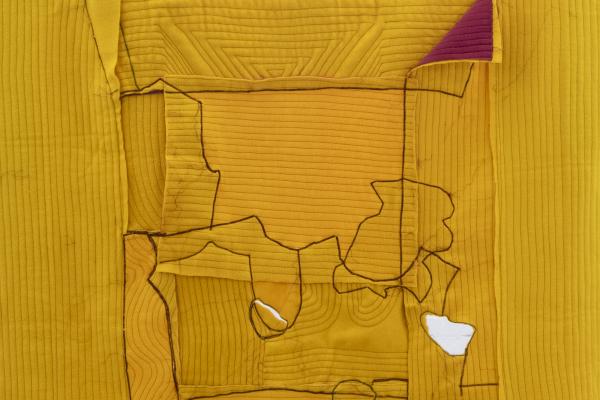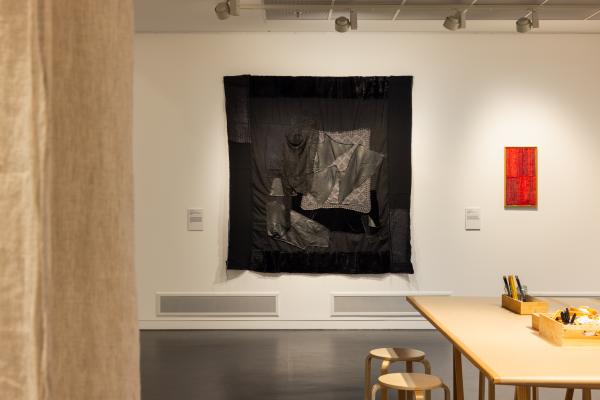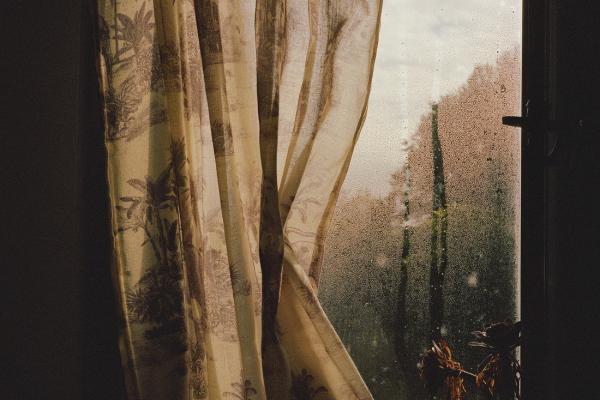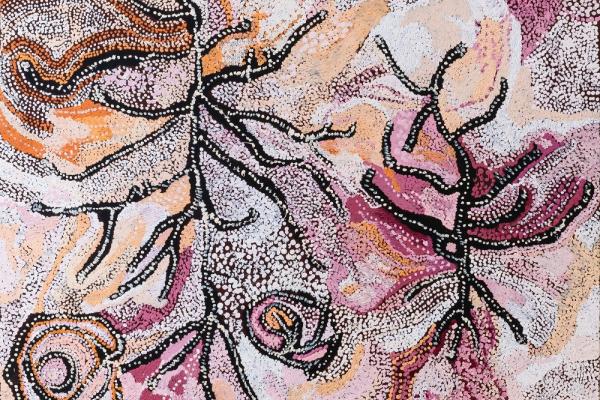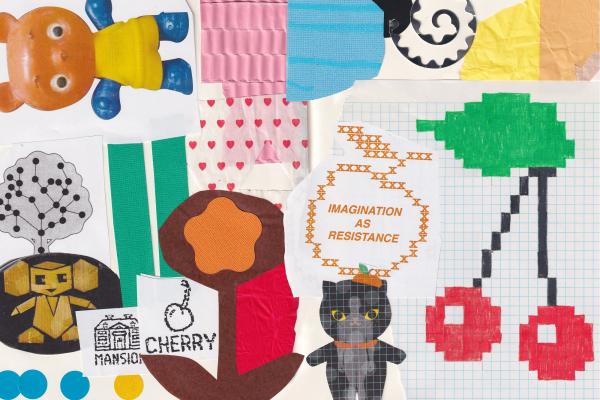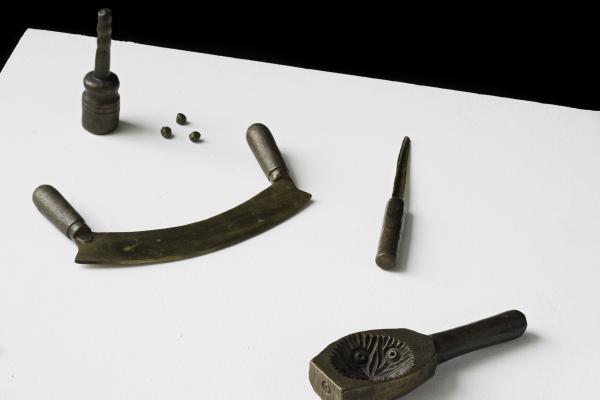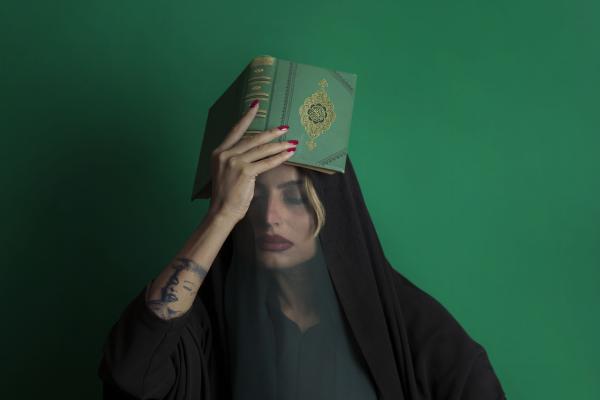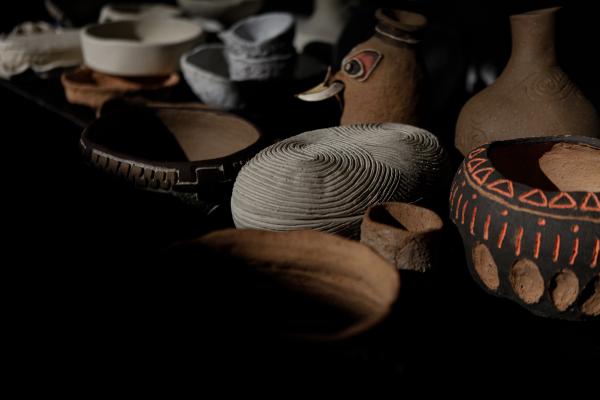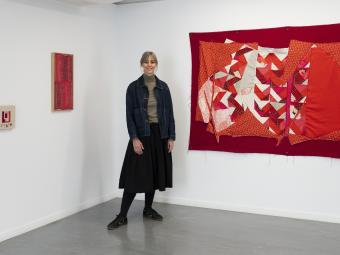| Title |
Description |
Year |
|
David Ray
WILD
2017
Earthenware, decal enamel gold, hand built
48 x 40 x 36 cm
Winner of the 2017 Manningham Victorian Ceramic Art Award
Manningham Art Collection
Image courtesy the artist
|
"Within my work I apply critical comment to contemporary consumerism and the less reputable aspects of our national identity through often flamboyant baroque creations. WILD explores the juxtaposition between the perception of the beautiful and the ugly. Decoration is incorporated within the body of the work, weaving, twisting and turning, with a confounding plethora of images, motifs and decals – the ‘glamour of the artificial’ colliding, almost in total meltdown. The hand of the artist is never far from one’s consciousness when viewing my work, which is intentionally imperfect, asymmetrical and sometimes seemingly top heavy. Also lingering in one’s awareness is the nature of ceramics; usually pristinely designed and immaculately fashioned and fragile. These two opposing qualities are a reaction to the overriding influence of machines as opposed to the natural." - David Ray, 2017.
|
|
|
Tim Clarkson
Washed Away
2017
Earthenware, hand built
45 x 60 x 40 cm
2017 Merit Award Acquisition
Manningham Art Collection
Image courtesy the artist and Skepsi Gallery
|
"Some say the world is getting hotter, some say this is due to mankind’s impact upon the earth, yet others refuse to acknowledge that the environment around us is changing and in a rapid way. With more information and knowledge at our fingertips than ever before, why is it that many of us just don’t see the impact our actions are having on the world around us? With each day, we are given the opportunity to do something about it, yet for something so critical to our future survival, there is little being done about it. Since 1992, melting ice from both poles have been responsible for a fifth of the global rise in sea levels, with the polar ice sheets melting faster in the last 20 years than in the last 10,000. The work titled Washed Away looks at how other inhabitants of this world are suffering the consequences of our own actions. Global warming is altering key habitat elements that are critical to wildlife’s survival and putting natural resources in jeopardy. Studies have projected that the Arctic could see its first ice-free summer as soon as 2020." - Tim Clarkson, 2017.
|
|
|
Magdalena Dmowska
Still Life
2017
Mid-fire clay, underglazes, porcelain slips, hand built, plaster monoprint
Dimensions variable
2017 Merit Award Acquisition
Manningham Art Collection
Image courtesy the artist
|
"When approached in the round, my ‘still life’ of ceramic forms references domestic objects, architecture and the body, whereas from a distance it references painting. Painting is confined by its frame, or self-contained by its edge as it encounters the wall, while ceramic objects work in the round, hence they frame themselves as the ‘clothing of emptiness’. I want my work to show the special power of ceramic forms through their association with tactility and the familiar, as they create intimacy with the viewer, contrary to the experience of separation associated with painting. My work explores the manipulation of familiar forms in order to move the viewer’s attention towards the metaphysical aspects of ceramic objects soothingness and lastingness, the metaphor for the perceptible representing the immaterial. I want the viewer to think about the inside of the closed forms, to embark on a journey of discovering what is really present in the space – the still life of ceramic forms translated into abstract painting. Beyond the art gallery, ceramic objects are perceived through their socially embedded meaning associated with function. My work demonstrates that ceramic forms can operate as hybrids, referring to the function while completely abandoning it in order to embrace the container as the ‘ultimate form of abstraction’." - Magdalena Dmowska, 2017.
|
|
|
Bridget Foley
Shifting Sands
2017
Porcelaneous stoneware, nickel yellow glaze, wheel thrown, reduction fired to 1300⁰C
Dimensions variable
2017 Merit Award Acquisition
Manningham Art Collection
Image courtesy the artist
|
"The movement of the glazes and the irregular line that moves around the vessels where the glazes overlap evokes the shifting lines of sand that occur when tides come in and out. I have spent many hours walking along the beaches on the Surf Coast of Victoria. These experiences get expressed in the work I make." - Bridget Foley, 2017.
|
|
|
Eva Glac
Corymbia Pectus
2017
Porcelain, raku, clear glaze, crackle glaze, gold luster, pink oyster, wood, polyclay, wax, handbuilt
Dimensions variable
2017 Merit Award Acquisition
Manningham Art Collection
Image courtesy the artist
|
"Duality and duplicity, the agony and the ecstasy of reproduction and sexuality. A species may employ illusory tactics for its reproduction and survival. Unwitting suitors and would be predators see what they want to see or are tricked into seeing. However, no human is a tool for someone else’s purpose. They are not owned, exchangeable or reduced to mere flesh. Body parts are beautiful and are not things without personality or dignity. We are slowly adapting to survive the verbal and physical abuse that is the result of objectification. Will we change physically, behaviorally or physiologically? The Eucalyptus flower buds are for your viewing, but do not ever touch the Corymbia ficifolia without my permission." - Eva Glac, 2017.
|
|
|
Dean Smith
Pine Forest
2015
Fine white stoneware, metallic glaze with fused enamel
49 x 30 x 10 cm
Winner of the 2015 Manningham Victorian Ceramic Art Award
Manningham Art Collection
Image courtesy the artist and Alcaston Gallery
|
"This artwork focuses on the link between the worked ceramic form and the disquieting landscape near my home. The gold-mining activity of the past has left the landscape disordered and jagged. The jagged line is echoed not only in the topography and quartz reefs but in the dry, brittle vegetation - the bare twigs whose reflections are amplified and multiplied in the dams and reservoirs. These observations are worked into my ceramic form as surface markings, through scoring and drawing with enamels and palladium. The landscape has contrasts of light and shade, past and present. The tannin-stained dams, the shadowy pine plantation, unearthed metal relics, scorched white bones and unexplained objects, sounds or past movements. My vessel-like form refers to the randomness and order I see in this particular landscape - the unexpected elements translated through strong contrasts and subtle nuance in the sculptural form." - Dean Smith.
|
|
|
John Dermer
Salt Glazed Porcelain Vessel
2015
Porcelain, salt glaze
34 x 20 x 20 cm
2015 General Acquisition
Manningham Art Collection
Image courtesy the artist
|
"I have pursued the demanding and often frustrating discipline of salt glazing for almost fifty years. Couple this with my preference for working with porcelain, and the potential complications are amplified. However, this is a conscious choice I make and not some perverse form of self-inflicted pain! After much experimentation with various clay bodies I find that the porcelain provides me with a clean palette and a fine surface which underlays, and integrates with, the materials I apply to react with the salt. For my purposes the clay body is as integral to the form as it is to the nature of the surfaces I seek - it does not remain hidden as with most conventional glazing and firing techniques. I view the salt kiln as an extension of my hands. It is a final tool in the process of making pots. Unlike alternative glazing techniques, salt glazing requires a huge investment in time and money through the construction, maintenance and firing of these dedicated kilns. It is not a ceramic field to be taken lightly. Over the years I have persistently endeavoured to push the boundaries in order to break away from the universally accepted limitations of the salt glazing process. After relentless experimentation and research, many disastrous failures, kiln calamities and some lucky mistakes I have been able to achieve surface textures and colours that are totally unique in the history of salt glazing. However, this pot presents a surface that I have never seen or achieved previously. I also fear I may never again! My aesthetics are a reflection of the traditions and values of the Leach-Hamada movement. I believe in a balanced form, an honesty of process towards materials and a respect for the timelessness of presence. When this pot emerged from the kiln I was both stunned and elated. The proud, organic forms and the subtle nuance of colour and surface texture appear to have been born and not created. They have integrity, beauty and presence. They encourage me to continue to seek the magic pot. A pot that will live far beyond me, but would proudly occupy any place along the historical timeline." - John Dermer.
|
|
|
Kate Jones
My Fake Name
2015
Terracotta, slip, glaze
73 x 70 x 45 cm
2015 Award General Acquisition
Manningham Art Collection
Image courtesy the artist
|
"The combination of painted surface and sculptural form creates an ambiguity that questions assumptions about both genres. This allows the work to sit in a liminal space that affords a realm of possibility in which new configurations of ideas and relations can occur." - Kate Jones.
|
|
|
Irianna Kanellopoulou
Wild Things Roam
2015
Ceramic, glazes
29 x 29 x 12 cm
2015 Valley of the Arts Award
Manningham Art Collection
Image courtesy the artist
|
"My practice is largely involved with the creation of individual ceramic forms that create a narrative and explore issues of identity, (dis)placement, unity and movement. I often utilize collected images and objects of our environment and popular culture to explore the persona and emotional associations with our immediate environment and memories, real and invented. I am interested in using the figure as a cultural object to project a narrative of surreal reality; a super reality. The work is infused with symbolism and it personifies imaginary dialogues, deliberately shifting relationships while drifting in and out of an augmented reality. Different characters and personalities are captured in a fleeting moment to reveal a network of masked identities, fragmented conversations and hidden emotions. Focusing on the micro the work draws our attention to the small details which are often overlooked. This microcosm, at times humorous and bizarre, highlights the transformation and personification of such images as a means of making sense of our surroundings, our environment and ultimately ourselves. Drawing inspiration from 18th century European porcelain, the work fuses the traditional with the modern and utilizes traditional techniques that are rapidly being lost through modernization." - Irianna Kanellopoulou, 2015.
|
|
|
Susan Robey
Campanile
2015
High fired earthenware, handbuilt ceramic paperclay
32 x 13 x 12 cm
2015 Award General Acquisition
Manningham Art Collection
Image courtesy of the artist
|
"As an architect and ceramic artist I use architectural imagery to make ceramic objects that are about the boundaries between one kind of space and another - outside and inside, hollow and solid, open and enclosed. I play with mass and scale in both form and surface texture and make reference to architectural elements such as walls, windows and columns. With soft, flexible cast clay slabs, I draw on my detailed understanding of architectural structures to construct thin walled objects with the lightness of paper but the solidity of buildings. I have adapted builders' techniques to my handbuilding processes including the use of formwork and the application of carpentry joints such as the mitre and the dowel. I use the static and inert in architecture to create the illusion of animation. I want the objects I make to be challenging and ambiguous." - Susan Robey.
|
|
|
Prue Venables
Porcelain Sieve No. 1
2015
Jingdezhen porcelain, fine silver
12 x 26 x 12 cm
2015 Award General Acquisition
Manningham Art Collection
Image courtesy the artist and Mossgreen
|
"A search for simple, quiet, innovative forms to be held and used; the translucency of porcelain with light dancing on the sprung tension of a rim, the softly melting body inviting touch; even the frustration of failure - all motivate my work. The procedures and intelligence of making hold my attention. I delight in the relationships that spring and develop between objects as they stand together like elements of musical harmony. From the shadows that form between them to the implied movements across spaces, they dance. An exploration of technical invention with origins in both studio and industrial spheres now enables handles to be fired separately, suspended, to be joined later. Such high risk practice leads to objects that have a sense of impossibility and without the encumbrances of limitations defining them even while they are still an idea. Silver components extend formal possibilities and facilitate the strengthening of joints between sections. The silver material and new techniques has enlivened my understanding of the porcelain I thought I knew so well." - Prue Venables.
|
|
|
Petrus Spronk
Landscape of the Mind
2013
Clay, smoke, flames
16 x 26 x 26 cm
Winner of the 2013 Manningham Victorian Ceramic Art Award
Manningham Art Collection
Image courtesy the artist
|
"My new series of work is concerned with the magic of the firing process. The throwing of the bowls is the same, though more refined. The burnishing of the bowls is the same, though more refined. The preparation for firing is as it has always been, but more finely skilled. With this work it is the firing process in the wood-fired kiln where the emphasis lies: the enriching of a surface imbued with flame and smoke markings, extracting from the kiln is visual magic, enhancing the work with kiln mysteries, painting the surface of the bowl with a brush loaded with fire and smoke, creating landscape images in its primal form, returning to the source, something raw with something refined, and there lies the necessary tension in the work; the tension which gets the attention." - Petrus Spronk.
|
|
|
Alan Constable
Not titled (Blue Concertina Camera)
2013
Ceramic, glaze
25 x 28 x 15 cm
2013 Valley of the Arts Award
Manningham Art Collection
Image courtesy the artist and Arts Project Australia
|
Constable’s sculpture is a lyrical interpretation of a technical instrument and the artist’s finger marks can be seen clearly on the clay surface like traces of humanity. In this way, Alan Constable’s camera can be viewed as an extension of the body as much as a sculptural representation of an object.
|
|
|
Neville French
Mungo Light 7
2013
Porcelain
24 x 28 x 25 cm
2013 Award General Acquisitions
Manningham Art Collection
Image courtesy the artist and Mossgreen
|
"My work involves an exploration of elemental porcelain vessels. Through each work, I try to distil an essence of place and evoke notions of quietude and transcendence through the expressive use of glaze and its relationship to form, space and light. The Willandra dry lakes region in southern New South Wales is a World Heritage site of profound significance for its record of geological evolution and human cultural record of earliest Australians. At Lake Mungo the land has been sculpted by climatic changes spanning millennia and the vast basin, silent spaces and ephemeral effects of light, weather and time, inspire my current work. In response to this extraordinary Australian landscape – a place of great spiritual significance – I have gently altered this wheel thrown piece to evoke a poetic sense of the vast topography whilst extending the glaze matrix to achieve subtle shifts in the colour and light on the form." - Neville French.
|
|
|
Terunobu Hirata
Facetted Vases with Triangular Top
2013
Stoneware
29 x 22 x 22 cm
2013 Valley of the Arts Award
Manningham Art Collection
Image courtesy the artist
|
"For more than 30 years, I have lived in Australia after leaving my home country, Japan. The life in Australia has always reminded me of my origin as Japanese. My passions have been to express the emotions and feelings I have had through the life in Australia into my work. Also, tasks such as working with clay, throwing on the wheel and firing the kiln give me a sense of satisfaction through interacting with nature. They are a source of my inspiration although they can be distressing at times. I have been fascinated by the ash glaze on dark body. This work gives the feeling of harmony of movement and tranquility. I draw upon the Bizen pottery style from Japan which influences my dark surfaces and undecorated forms. I have been experimenting with various methods to fulfill my passions for pottery. I have been excited and thrilled with what I do as a potter." - Terunobu Hirata.
|
|
|
Janetta Kerr-Grant
Urban Light, Winter
2013
Stoneware
31 x 29 x 13 cm
2013 Award General Acquisition
Manningham Art Collection
Image courtesy the artist
|
"I am interested in how a particular sense of place is conveyed in ceramics. For the past few years I have been drawn to the urban iconography of freeways. My inspiration derives from frequent travel, often at dusk, along the Western Highway. The soft haze of twilight dissolves the heavy traffic, streetlights and road signs into a richer more ambiguous landscape. In this diffuse half-light these ordinary, even banal, vistas are transformed into landscapes of unexpected and fleeting beauty. Working from reference photographs, I use this imagery as the starting point to produce elemental ceramic vessels that explore notions of mood and atmosphere." - Janetta Kerr-Grant.
|
|
|
Vanessa Lucas
Stone Jugs
2013
Slip cast porcelain
26 x 46 x 24 cm
2013 Award General Acquisition
Manningham Art Collection
Image courtesy the artist and Woodbine Art
|
"A single smooth dark stone among rough grey rocks on a deserted beach in Tasmania suggested the form of these jugs and the dark satin glaze. The jug series has emerged with variations from the primary immutable form, each descending shape seeming to fall naturally from the largest vessel." - Vanessa Lucas.
|
|
|
Tracy Muirhead
Utensils
2013
Porcelain
30 x 104 x 4 cm
2013 Valley of the Arts Award
Manningham Art Gallery
Image courtesy the artist
|
"Utensils have been used by man for millennia. They are useful, practical objects, but the use of tools and utensils is not unique to humans; in fact gorillas, chimpanzees, elephants and birds have been observed using stones, twigs and bone shards to help obtain a desired object or substance. Today, we regard table manners and the ability to wield cutlery as a mark of sophistication.This series of utensils removes all pretension of sophistication in that they are basic, verging on crude, yet as a group, make an elegant statement where the whole is greater than the sum of its parts." - Tracy Muirhead.
|
|
|
Christopher Headley
Forgotten Worlds
2011
White earthenware, glaze, decals, platinum lustre
75 x 30 x 25 cm
Winner of the 2011 Manningham Victorian Ceramic Art Award
Manningham Art Collection
Image courtesy the artist
|
"Forgotten Worlds responds to memory and emotion. The intention of the work is to allow the viewer time to reflect on the past. Guided by the rich assembly of images that create a history - the broken fine china plate, the idealised view of nature and the dream of flight. Such histories are recorded and projected into present time and we connect with them through our emotions - such as melancholy. Melancholy is thus evoked in the context of quiet reflection, evoking memories of both happiness and sadness." - Christopher Headley.
|
|
|
Paul Wood
L. N. Fowler
2011
Found ceramic, glass objects
22 x 42 x 28 cm
2011 Valley of the Arts Award
Manningham Art Collection
Image courtesy the artist
|
"I begin new work by gleaning op shops, ebay and second-hand shops for unwanted ceramic objects. These are piled into a kiln and fired. Their shape and glazes melt, warp and fuse together into new forms. I am interested that their previous existence in one’s everyday domestic life to their rejection as non-fashionable ‘clutter’ are given a new life and resurrected into small monuments to their past circumstances. Their new rather wilted form expresses the exhaustion of their previous domestic setting. L.N. Fowler is a re-produced Phrenology head lying on its side on a pile of platters. A glass bowl is melted over its head. The leaf imprint on the melted glass bowl becomes like a textile pattern on a cloth head scarf. Gone is the previous brittle and rigid state of the bowl. Now it is fluid and feels light like a piece of muslin cloth. Tucked inside the Phrenology head’s bust are two miniature figurines. In their earlier context they may have seemed innocent and a little banal. Perhaps they sat on a quiet mantel piece. In their new context there is something a little darker coming into play. Looking closely at these two figurines you notice that the male figure has been beheaded. The Fowlers head, previously used for science and now lying on its side on some platters and clothed in a beautiful scarf also alludes to a more sinister narrative. Perhaps a King or Queen has called for its head to be chopped off and served on a platter!" - Paul Wood
|
|
|
Brian Keyte
Phi Triptych
2011
Stoneware, shino type glaze
15 x 60 x 40 cm
2011 Award General
Acquisition
Manningham Art Collection
Image courtesy the artist
|
Humankind has evolved within the natural world. I reason, therefore, that if one can utilise nature’s design rules then the product will rest easy on the human eye that has evolved with it. As the golden mean or phi seems to be what nature uses, each piece is made with this in mind as a guide to structure, with the plastic nature of the clay and the intended glaze contributing to the final form. I constantly work with the ratios of a form’s elements in mind. Thus much of my work could perhaps be classed as an engineered structure. The calculated rhythm of a wave formed rim, and the careful forming of a bowl shape coming close to perhaps a sine wave, a catenary or parabolic curve. Some may see these forms as clinical in their calculated aesthetic, but they are informed by nature as the mathematics behind them is simply the mathematics that falls out of the natural world when we study it. It is the Cartesian mathematics of Descartes, Newton, Venturi and others who simply observed nature in fine detail and sought to explain it in the language of numbers. With an understanding of these rules and a piece constructed to them, I can then break those rules to move beyond this clinical thoughtful foundation and add creative flair unbounded by them.
|
|
|
Robyne Latham
Strange Fruit
2011
Stoneware
23 x 26 x 46 cm
2011 Award General Acquisition
Manningham Art Collection
Image courtesy the artist
|
The mystique of saggar firing is captivating. The process is complex from beginning to end, from wedging the clay to firing the work. It invariably requires the artist to juggle the potential of intuition with the whisper of serendipity. The inevitable and unavoidable flip-side of this magic, due to the very nature of the firing, is the possibility of a disaster. Frequently, one can open the kiln to find hours of work have literally ‘gone up in smoke’. This necessitates the artist to develop a sound and philosophical resilience to the loss of works. Works which do endure a saggar firing however, emit a unique quality, borne of the coalescence of earth, fire, water, air and space. This unique quality can challenge the construct of time. With curiosity one can ask, “Could this work have been created last week or a century ago?” The works, Kick’n Goals and Strange Fruit address timeless themes of the human condition. Both works explore the co-existence of beauty with ugliness, and grace with trauma. On one hand humans can create a sculpture, a garden or a symphony of such beauty, and concurrently such violence and destruction. There exists a synergy between the unique quality of saggar fired work, the intent of challenging the construct of time and the exploration of universal themes.
|
|
|
Tina Lee
The Karens'
2011
Ceramic and various glazes
120 x 120 x 110 cm
2011 Award General Acquisition
Manningham Art Collection
Image courtesy of the artist
|
"After collecting ceramics for 10 years I have become interested in the ceramic objects that people do not collect. The objects discarded or rejected and existing on the periphery of good taste. My current body of work juxtaposes elements of the highly sought after collectable with elements of the undesirable object relegated to the junk pile. The small ceramic vase in the opportunity shop that no one ever buys has become an object of focus. I decided to call a forlorn, common 1950s vase, Karen. Like the vinyl LP’s of Tijuana Brass, Kamahl and Karen Knowles, she is always available. She is usually two dollars. She is dependable. The slip cast shell that is covered in a dry textured glaze characterizes Karen. She is one of probably thousands cast so many times the relief decoration is hardly legible. In the ceramic world, Karen competes with the handcrafted, the one-off, the authentic, and the unique collectable object. In the hierarchy between the handmade and the slip cast multiple, she remains at the bottom. But that is what is appealing about her. After living with her for a while, her simple ordinariness begins to grow on you. The psychology of the mass produced is comforting to us because it’s everywhere—past and present." - Tina Lee.
The Karens' is permanently displayed above the entrance to Manningham Art Gallery.
|
|
|
Vipoo Srivilasa
Child's Play
2011
2011 Award General Acquisition
Ceramic, glazes
70 x 25 x 18 cm
|
"Child’s Play is a piece from the series Bloody Bangkok. This series is a response to the red shirt and yellow shirt protests that have occurred in recent years." - Vipoo Srivilasa
|
|
|
Michael Doolan
Bear Family
2009
Ceramic, platinum lustre
Dimensions variable
Winner of the inaugural 2009 Manningham Victorian Ceramic Art Award
Manningham Art Collection
Image courtesy the artist
|
"My work, inspired by popular culture and finding expression in a 'world of the toy' de- and re-construct childhood imagery. They engage the viewer with this world. Intentionally set up to be viewed through the eyes of an adult while still allowing us to participate childlike, in this 'world of the toy'. My aim is to capture and reveal the invisible, hidden qualities of the miniature. Their featureless countenance employed to subvert “my” subject’s visually-friendly nature. A major feature of these works is their high gloss reflective finish. This mirror-like finish will force the viewer to engage with the work as an active and intimate participator, so they observe themselves as a distorted reflection. There is an intention with this work to question the way we perceive ourselves in the world, in this case, my world of the toy, around them." - Michael Doolan.
|
|
|
Tim Clarkson
Set in Stone 2
2009
Ceramic, glaze, decals
28 x 30 x 18 cm
2009 Valley of the Arts Award
Manningham Art Collection
Image courtesy the artist
|
"Long intrigued with the art of origami, this work reflects ceramic sculptures based on typical origami forms. The forms are then used as canvases in which current issues that we are facing in the world today are expressed. Whilst researching origami, the crane was used as a starting point. Although this form is one of the most commonly known origami folds in the world, it was the history behind the origami crane that made it the perfect subject matter. The crane is strong, graceful and beautiful, and is a symbol of loyalty and honour. Each year thousands of paper cranes are folded around the world as ways of promoting peace, making friends and also honouring those whose lives were destroyed in the bombing of Hiroshima. By using the ceramic medium, the forms are created and imitate the paper qualities of origami, whilst also giving the work a more permanent existence. From the sharp angular lines to the crisp paper folds, all elements of the paper crane are recreated to symbolise the precision and geometrical forms found in the art of origami. With the use of custom decals, the newspaper print further adds to the illusion of paper. Almost 60 years on we are still faced with the threat of nuclear attacks, with the rise of civil restlessness in the Middle East testifying to this. With reference to the Hiroshima bombing the work connects the past with the future reminding us that history has a way of repeating itself." - Tim Clarkson.
|
|
|
Ann-Maree Gentile
When Manningham was a Road
2009
Paper clay, underglaze
Dimensions variable
2009 Valley of the Arts Award
Manningham Art Collection
Image courtesy the artist
|
"When I was growing up Manningham was a road, a road that lead to my Nonna and Pop’s, Aunties and Uncles and the Doncaster Baths. Now it’s a municipality. For a very long time Doncaster was my world. I lived there, went to kinder and school there and all my friends did too. The landscape, places and people of Doncaster inhabit many nooks and crannies in the memory section of my brain. I have taken this opportunity to explore some of my childhood memories, there is nothing earth shattering in fact it makes me wonder how some of these memories are so vivid while others have just faded away. Sometimes when we speak of these times people ask how do you remember something so obscure and when they talk I wonder if I was really there. Long live the joy of finding a plastic toy in cereal box and the strange machinations of memory." - Ann-Maree Gentile.
|
|
|
Victor Greenaway
Spiral Lipped Bowl, Imperial-Yellow
2009
Porcelain, glaze
18 x 19 x 17 cm
2009 Award General Acquisition
Manningham Art Collection
Image courtesy the artist
|
"The strength of my work is in the ability to create spontaneity in each piece during the session on the potter's wheel. As a brush or chisel is the tool of a painter or sculptor, so too is the wheel mine. The dynamics are created through light and shade, modelled through the use of indentations and various surfaces and colours. The translucency of the porcelain contributes to this by passing light through thin linear markings and fine edges. As in a quick sketch or abstraction the outcome relies on experience, intuition and a confidence in technique. Often the result is uncertain and the work lost or discarded but the journey is an exciting one and constantly rewarding. I look for glaze surfaces to enhance the form and lines by creating light and shade, adding dynamic energy to the piece. I often find glossy glazes to be too distracting so tend to select glazes that are more satin or matt. I also produce work that follows the specialist techniques of the black Etruscan bucchero firings. It provides a beautiful and appealing contrast to the high-fired, pure white of the Limoges porcelain." - Victor Greenaway.
|
|
|
Wendy Jagger
Firewheel
2009
Southern ice porcelain
20 x 20 x 20 cm
2009 Award General Acquisition
Manningham Art Collection
Images courtesy the artist
|
"Surrounded by the beautiful and sometimes austere alpine environment of Victoria’s North East, my work is strongly influenced by its seasonal landscapes. Field drawings are developed in the studio in a range of painting media or depicted in translucent porcelain imagery. Working with Southern Ice porcelain, etching the imagery, layer by layer into the thrown walls of the vessel is painstaking and fraught with danger. At any moment, the bone dry clay could shatter, as I rub away at the shellac resist, eroding the surface. Yet it is exciting. It’s like painting with light. It’s like a treasure hunt, as I search for that luminous translucency. It is a quest of passion. Firewheel came about when a shadow play of light cast dancing botanical patterns on the wall one afternoon. Different densities of light passed through the growth of the native shrubs outside the window. Firewheel has been delicately double etched, on the interior and exterior of the form to recreate this shadow play." - Wendy Jagger.
|
|
|
Irianna Kanellopoulou
Dreamscape
2009
Ceramic, glazes, polyurethane
20 x 32 x 3 cm
2009 Valley of the Arts Award
Manningham Art Collection
Image courtesy the artist
|
"In the piece Dreamscape different images of automobiles are fused together to represent the car as an important icon of desire as well as an embodiment of our personas, dreams & sexuality. I use a combination of handbuilding and slipcasting techniques, exploring the sculptural and plastic qualities of clay in a contemporary context. Working with modules and different components allows relationships between forms to develop, investigating the life of an object outside of its initial intent and purpose. I seek to merge traditional hand crafted ceramic techniques with industrial methods and processes to achieve a fusion of techniques. The integration of these contrasting elements is an essential aspect of my artwork and enables me to continue to explore and push the boundaries of my artistic practice." - Irianna Kanellopoulou, 2009.
|
|
|
Sally Lee
Morning Blush
2009
Southern ice porcelain, coloured stain
8 x 16 x 14 cm
2009 Award General Acquisition
Manningham Art Collection
Image courtesy the artist
|
Sally uses translucent porcelain for her work as she appreciates its fine texture and the way it provides for the passage of light through the form. She also enjoys the challenge of working with such a technically challenging medium. The technique of combining pattern, colour and design within the body of the vessel itself is her particular enthusiasm. In the union of luminosity, pattern and structure Sally is seeking to create an ideal of beauty inspired by nature. Her soft muted colours and designs take inspiration from anything from a simple rock, flower, a butterfly, fish or feather to the colours and forms of the Australian landscape. The irregular forms reflect the accidental deviations and variations often found in nature. Sally's pieces are exquisitely delicate and are not glazed as she feels that the subtlety of the forms can be better appreciated this way. The vessels are instead simply polished both before and after the final firing.
|
|
|
Mary-Lou Pittard
Breakfast Tray
2009
Stoneware
Dimensions variable
2009 Valley of the Arts Award
Manningham Art Collection
Image courtesy the artist
|
"Clay allows me to use many processors when forming my work. I enjoy the transformation from the soft pliable state through to the hard durable finish. I often push its bounders to see what I can produce sometimes to no avail but still find myself back the next day exploring again. Once the piece is made its shape often dictates the decorative elements. With every year my decoration seems to become more intricate. My love for food and cooking has always played a big part in my creating process. Ideas in the studio or dishes in the kitchen are inspired by the mood or flavour of the day. Like cooking I start with traditional ingredients but end up with something new and exciting. Mass production never interested me as a student, I never wanted to let go of the imperfections of the hand made object. Years ago I came across an unusual ceramic object in a Regional Gallery. It was titled “Asparagus Dipping Bowl ‘It was made especially for dipping asparagus I loved it. I also have a book on Victorian household goods that is full of obscure and extravagant objects. I enjoy combining elements of a ceramics tradition with my own artistic desires. They play on the functional decorative side, to use or not to use, ‘Breakfast Tray’ is for those lazy mornings to use out on the veranda or enjoyed displayed on the sideboard." - Mary-Lou Pittard.
|
|
